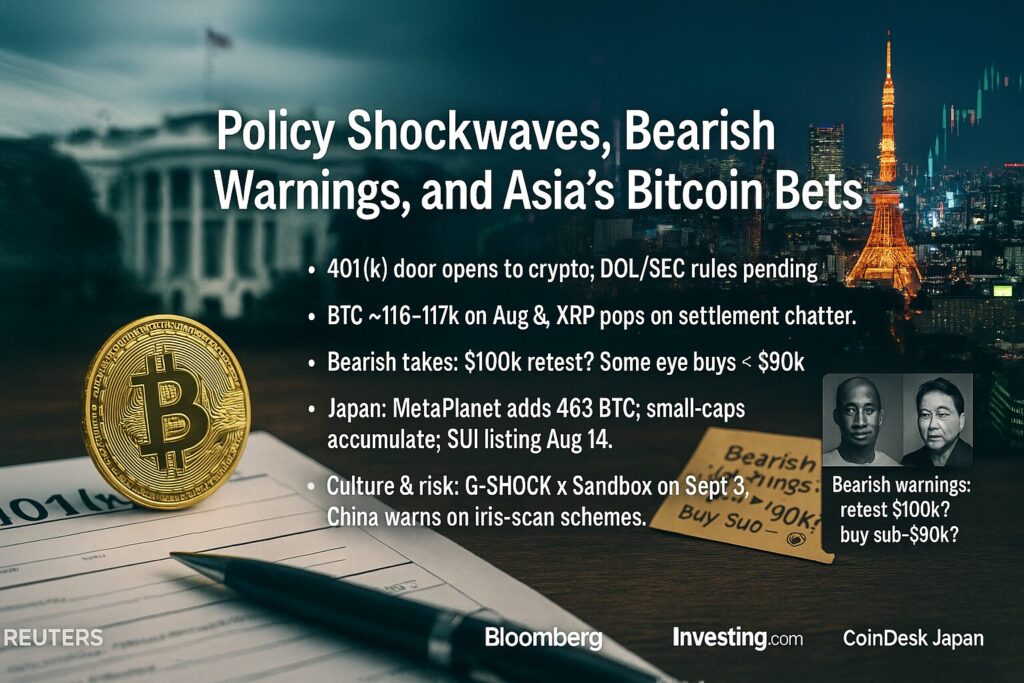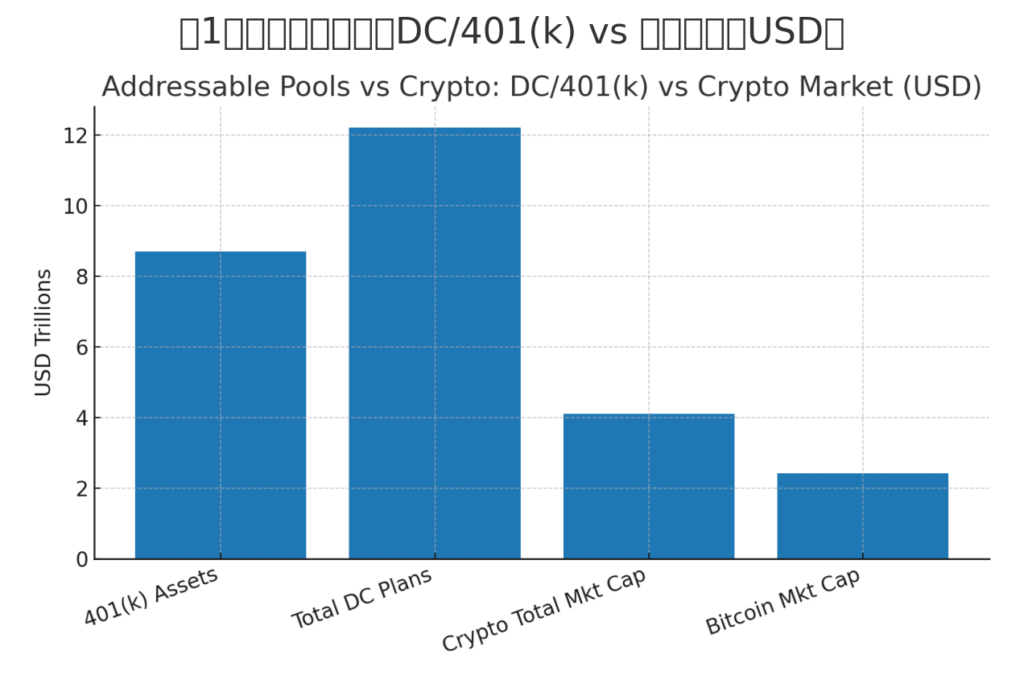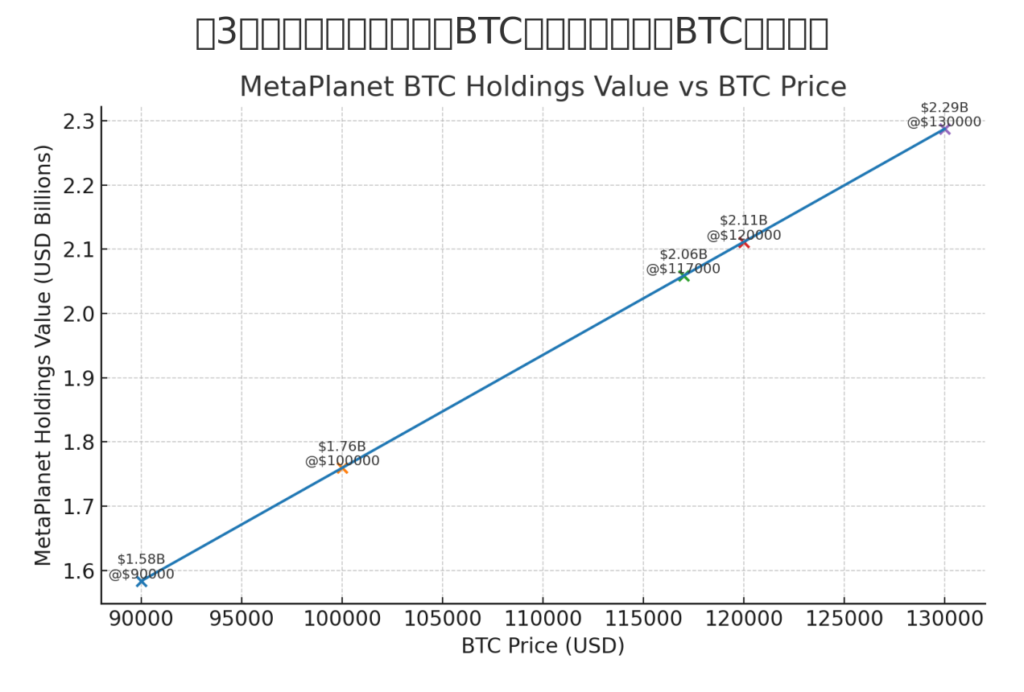
Main points:
- 401(k) breakthrough: President Trump signed an executive order enabling plan sponsors to include alternative assets—including cryptocurrency—in 401(k)s, potentially opening access to roughly $12–12.5 trillion in U.S. defined-contribution savings. Implementation still depends on follow-up rules from the Department of Labor and the SEC.
- Market reaction: Bitcoin traded around $116–117k on Aug 8, while XRP rallied on reports that SEC v. Ripple reached a settlement, ending a multi-year legal overhang.
- Bearish countercurrents: Arthur Hayes warned BTC could “retest $100k” and Robert Kiyosaki mused about buying more if BTC dips “below $90k”—reminders that near-term drawdowns remain very plausible.
- Asia momentum: Japan’s MetaPlanet bought 463 BTC (~$54.2M), lifting holdings to 17,595 BTC; smaller listed firms such as Kitabo/北紡 (3409) also added BTC. Meanwhile, Bitbank will list SUI on Aug 14.
- Web3 culture & risk: Casio G-SHOCK x The Sandbox launches a playable metaverse city Sept 3; China’s security ministry warned against iris-scan crypto schemes (Worldcoin-style), underscoring biometric-data risk.
[Insert Figure 1 here — “Addressable Pools vs Crypto: DC/401(k) vs Crypto Market (USD)”]

1) The 401(k) Executive Order: What actually changed?
On Aug 8, 2025, the White House signed an executive order instructing agencies to ease the path for alternative assets—including private equity, real estate, private credit, infrastructure, and cryptocurrencies—inside 401(k) menus. Media described it as a “big win” for asset managers who have long eyed the vast defined-contribution pool. Estimates vary, but you can think of the potential access in two ways:
- Total DC assets: about $12.2T (Q1 2025).
- 401(k) assets specifically: about $8.7T (Q1 2025).
Coverage emphasized the order’s directional nature: the Department of Labor and the SEC still need to update guidance (e.g., fiduciary standards, disclosures, valuation, liquidity handling, and litigation risk). In other words, this does not auto-insert crypto into every plan; it permits sponsors and their consultants to begin considering allocations once the rule-making is done.
Why the excitement? Because even small allocations in a $8–12T base move real money. If, hypothetically, 1% of 401(k) assets sought spot BTC/ETH ETFs (a route many sponsors prefer for custody and pricing), that would imply potential flows on the order of $87–$122B over time. For context, today’s total crypto market cap is roughly $4.0–$4.1T and Bitcoin’s market cap about $2.4T.
Takeaway: The EO is a process opener, not a guaranteed allocation. But it aligns retirement channels with the ETF-driven institutionalization trend already underway.
2) Prices and positioning: A pop with caveats
Spot prices into the news flow were firm: BTC hovered near $116–117k on Aug 8, depending on venue and time of day. XRP outperformed on reports the SEC-Ripple fight had been settled, removing one of crypto’s longest legal uncertainties.
Still, analysts cautioned that summer liquidity, seasonality, and profit-taking by long-term holders were in play, noting prior resistance bands around $117–122k for BTC.
What to watch next (tactical): whether the 401(k) story translates into ETF inflows in coming weeks; any DoL/SEC scoping memos; and how trad-fi allocators react to fees/liquidity concerns that critics highlight for alternative sleeves in retirement accounts.
[Insert Figure 2 here — “Key Crypto Market Catalysts: Aug 2–8, 2025”]

3) The bears aren’t gone: Hayes and Kiyosaki’s warnings
Against bullish headlines, Arthur Hayes (ex-BitMEX) said BTC could retest $100k, disclosing he rotated ~$13M from crypto into stablecoins amid macro headwinds (weak U.S. jobs data, tariff uncertainty). Robert Kiyosaki said he’d like to accumulate if BTC falls below $90k—a bearish near-term view wrapped inside long-term conviction.
These calls matter not because they must be right, but because they map the risk surface around policy headlines: macro data and liquidity still drive crypto beta. Several on-chain/market desks, conversely, continued to note accumulation and positive demand even on dips—consistent with what CryptoQuant and others have shown throughout the post-halving cycle.
Practical framing for traders: Respect the $100–112k downside window flagged by bears while planning entries for structurally bullish flows (401(k) channel development, corporate treasuries, ETF demand).
4) Asia’s treasury bid: MetaPlanet leads, smaller names follow
Japan’s MetaPlanet added 463 BTC on Aug 4 for roughly ¥7.995B (~$54.2M) at an average ¥17.27M per BTC ($117.1k), lifting holdings to 17,595 BTC. That puts the firm among the largest corporate BTC holders globally by coin count.
Other Japanese listed names are dipping in: Kitabo/北紡 (3409) disclosed 3.32 BTC cumulative (about $0.39M at ~$117k), and said it will DCA ¥2M/day ($13.6k/day) within an ¥800M (~$5.42M) budget, with explicit stop conditions if volatility or policy shocks hit. This kind of granular disclosure is rare in the West and is useful for treasury-policy benchmarking.
Meanwhile, U.S.-listed Bakkt (BKKT) struck a deal to acquire ~30% of Hotta Maruzen (8105.T) from RIZAP, becoming its largest shareholder to pursue a multi-national BTC finance strategy spanning Japan. This reflects the cross-border architecture forming around BTC treasury, payments, and retail financial services.
[Insert Figure 3 here — “MetaPlanet BTC Holdings Value vs. BTC Price (sensitivity)”]

Why this matters: Corporate balance sheets are sticky capital. Even relatively small Asian corporates adding BTC can smooth drawdowns and crowd in follow-on issuers, especially if preferred stock or other funding routes are normalized for BTC accumulation programs.
5) Beyond price: Culture, listings, and compliance risk
- Web3 culture: Casio’s G-SHOCK project will launch “G-SHOCK CITY” inside The Sandbox on Sept 3, with NFT avatars and in-world items—a marquee example of consumer brands using metaverse hooks to extend IP into crypto-native ecosystems.
- New listings: Japan’s exchange Bitbank will list SUI on Aug 14 across spot, buy/sell, lending, and DCA—another sign that Japanese exchanges are broadening L1/L2 coverage beyond BTC/ETH/XRP.
- Compliance watch: China’s Ministry of State Security warned about iris-scan token schemes (not naming but clearly alluding to Worldcoin-style data collection), highlighting biometric privacy and cross-border data transfer risk. Teams building identity rails or proof-of-personhood should expect tightening scrutiny in major jurisdictions.
6) How to trade and build around this week’s developments
A. For investors (retail and pros):
- Treat the 401(k) EO as a multi-quarter pipeline, not an immediate flow. Track: DoL bulletins, SEC staff statements, record-keeper integrations, and plan consultant model menus. ETFs will likely be the first conduit for retirement allocations.
- Use policy windows to scale core BTC exposure but pay attention to bear-case thresholds ($100–112k) for risk management; Hayes’ line in the sand is a useful reference.
- Monitor XRP after the reported SEC settlement; with legal risk receding, liquidity venues and product issuers may revisit coverage.
B. For builders (exchanges, wallets, fintechs):
- Position products for retirement-channel discovery: fee-transparent wrappers, clean pricing, and education that meets ERISA/DoL expectations.
- In Japan/Asia, explore treasury services (DCA rails, reporting dashboards, custody interfaces) for listed SMEs adopting BTC. MetaPlanet’s playbook (including potential preferred share issuance) is a template worth studying.
- If you touch biometrics or identity, assume data-sovereignty and explicit consent frameworks will harden; design for local storage or zero-knowledge proofs where possible.
7) Numbers that put it all in context
The sheer scale of retirement assets vs. crypto helps explain the market’s reflexive reaction to the EO:
- Total DC plans (Q1 2025): $12.2T
- 401(k) assets (Q1 2025): $8.7T
- Crypto total market cap (today): ~$4.0–$4.1T
- Bitcoin market cap (today): ~$2.3–$2.4T
[Insert Figure 1]

8) Bottom line
This week fused policy, price, and corporate adoption:
- The 401(k) move pulls crypto deeper into the mainstream savings architecture—if follow-on regulation makes it operational.
- Markets liked the signal, but seasoned voices reminded everyone that macro can swamp headlines; plan for two-sided risk.
- Asia, led by Japan, keeps turning treasury theory into practice, from MetaPlanet’s sizeable buys to exchange listing breadth and IP-driven metaverse activations.
For readers hunting new assets or income streams and practical blockchain uses, the message is simple: follow the pipes. Retirement channels (ETFs), corporate balance sheets (treasury), and consumer IP (metaverse/NFT) are the pipes that can sustain flows through volatile weather.

